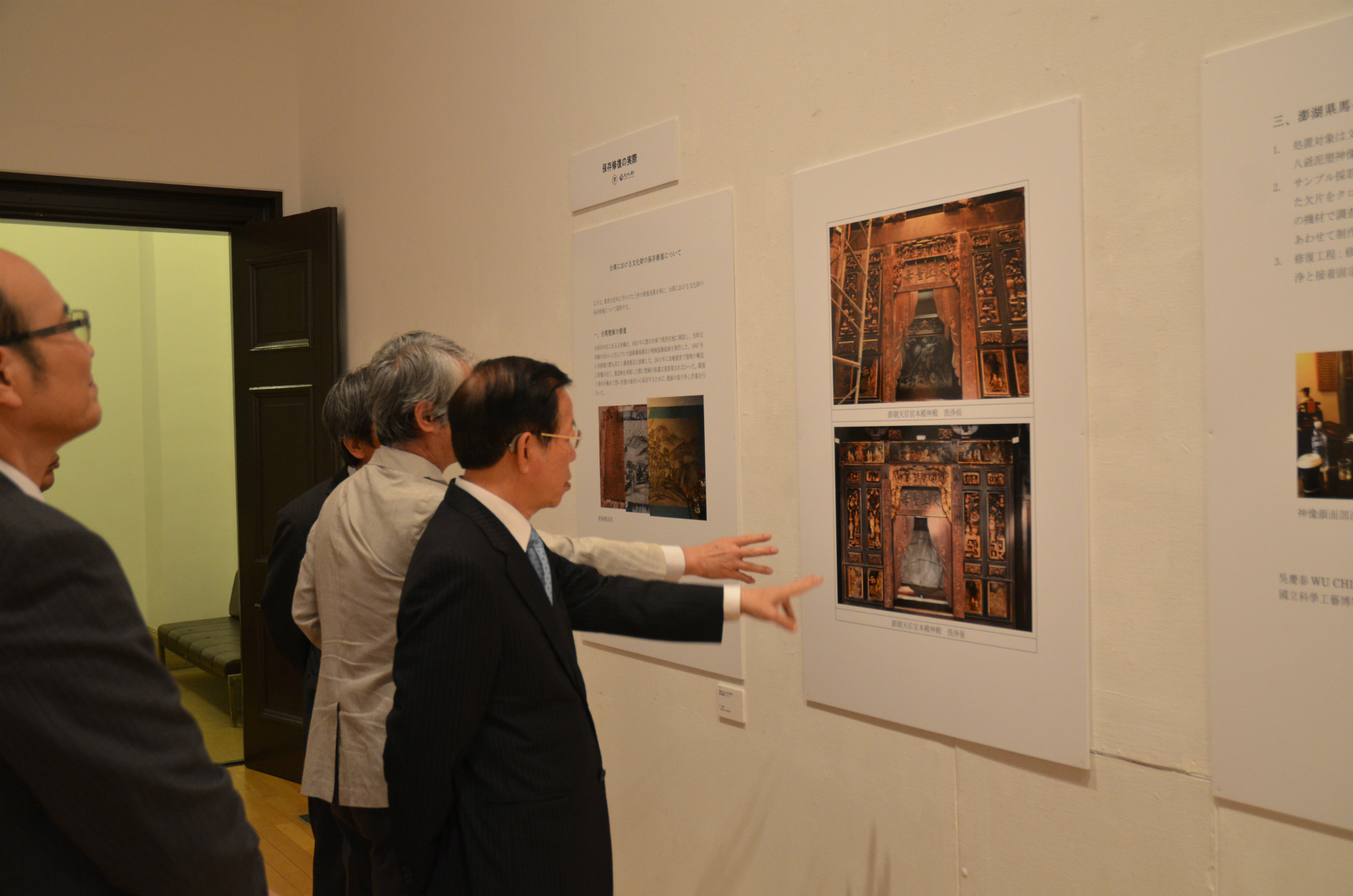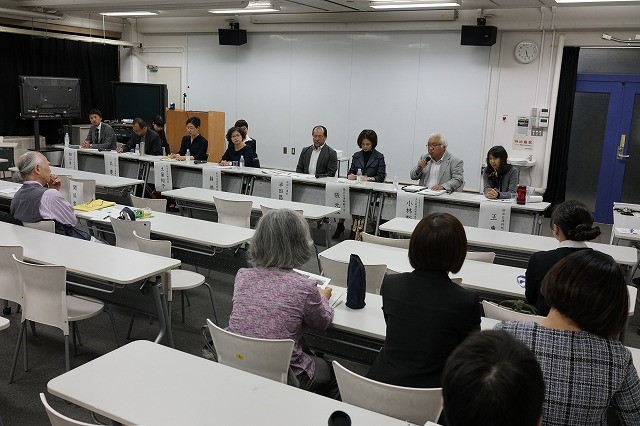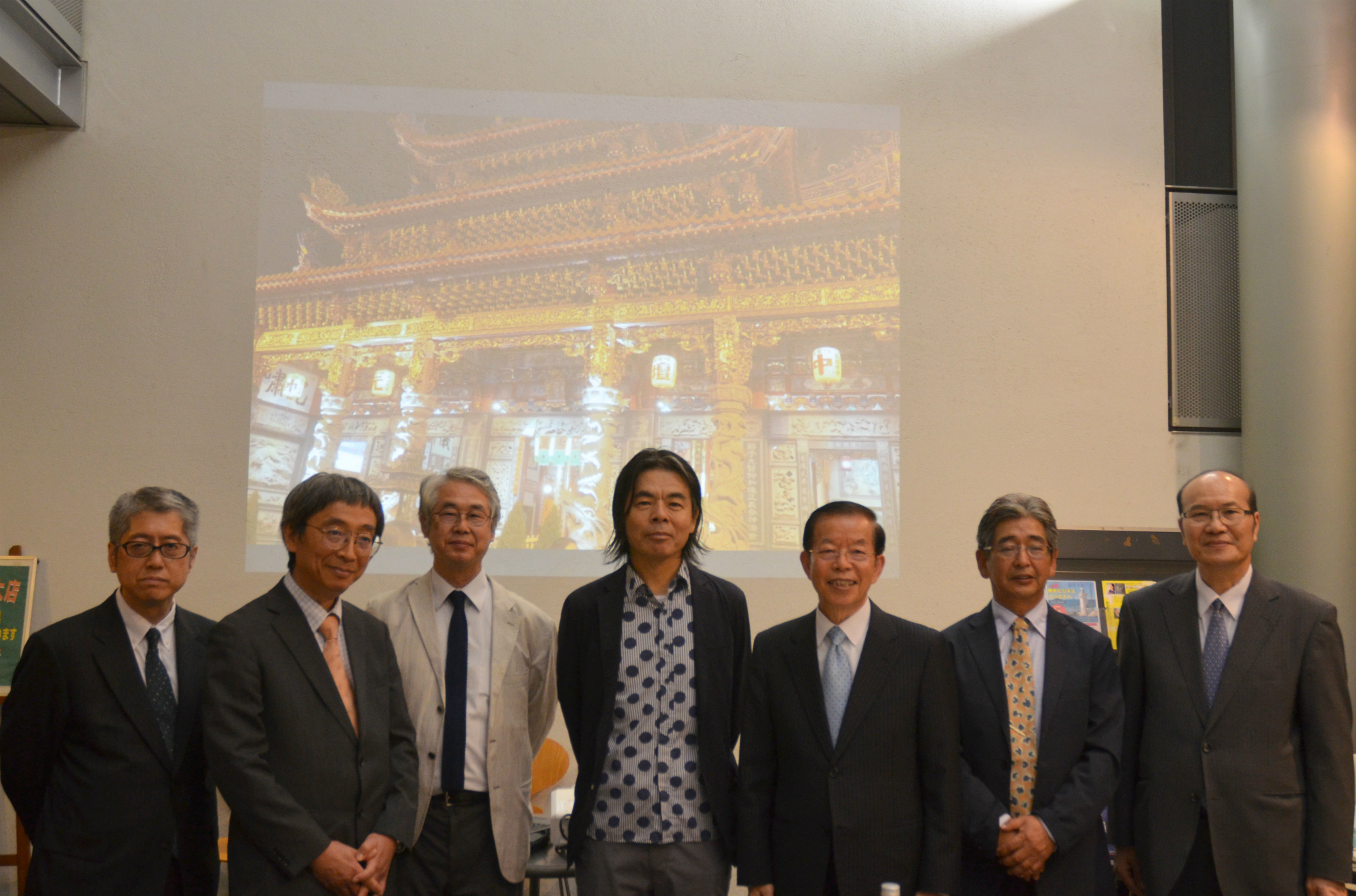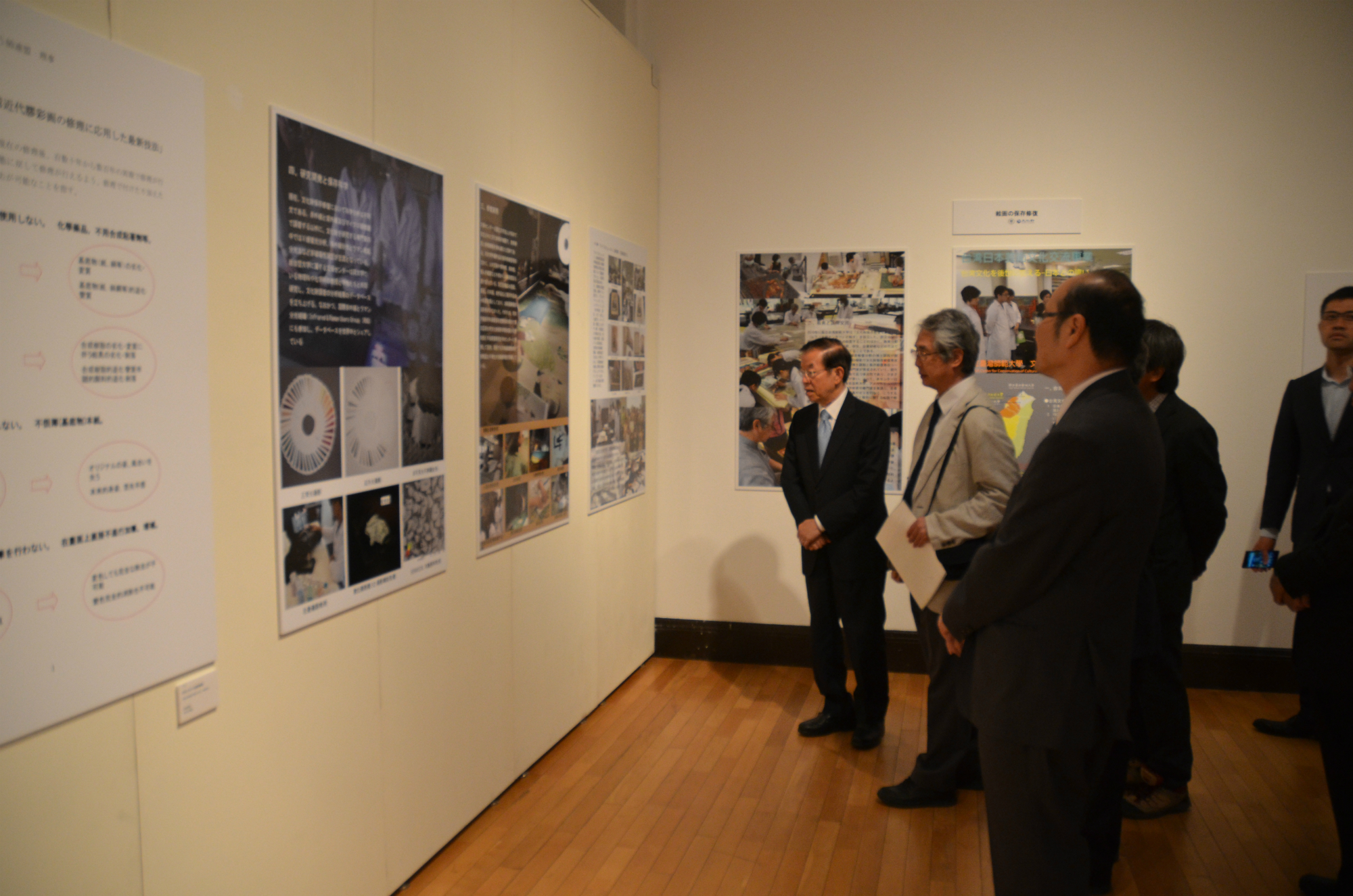台湾・日本芸術文化交流事業:台湾文化光点計画 「台湾文化を後世に伝える―日本との違い」展とシンポジウムの開催The Spotlight Taiwan Project "Hand down Taiwanese cultural properties to posterity: Difference between Taiwanese and Japanese conservation techniques"
October 16, 2017
9月27日~10月4日、台湾文化部と本学との共催による芸術文化交流事業「台湾・日本芸術文化交流事業 台湾文化光点計画」を実施しました。実施5年目を迎える今回は、本学美術学部国際文化財修復プロジェクト室が中心となり、「台湾文化を後世に伝える―日本との違い」と題して展覧会とシンポジウムを開催しました。
台湾固有の文化を後世に伝えるために様々な取組が行われています。たとえば歴史的建造物や扉絵、柱彫刻、各種絵画などの文化財には深刻な経年劣化が生じる物が数多くあります。このような文化財をより良い状態で後世へ伝世させることは現代を生きる我々の責務であり、こうした文化財を伝える取組の中心が保存修復になります。保存修復は多くの技術の中から対象の文化財に最適な技術を選択して作業を行いますが、その適用は一様ではなく、素材や時代、文化的背景などに応じて、文化財毎に個別対応をとらなければなりません。
また、修復された文化財の多くは美術館や博物館に収蔵されていますが、ここでは、「展示環境」と「保存環境」が眼目となり、このため美術館や博物館における環境整備も重要な取組となります。
そこで9月27日~10月4日に本学大学美術館陳列館で開催した展覧会では、「歴史的建造物の保存と活用」「絵画の保存修復」「美術館・博物館における保存活動」「保存修復の実際」というテーマ構成とし、このような文化遺産を取り巻く様々な取組を日本の修復技術との比較の観点から紹介しました。写真を豊富に用いた多数のパネルを展示することにより、台湾と日本の保存修復の関わりとアプローチの異同を分かりやすく解説し、専門家以外の方々にも広く関心を持っていただける展覧会としました。開幕初日には共催者である台北駐日経済文化代表処より謝長延代表と朱文清顧問も来場され、担当教授の案内で会場を御覧いただきました。

桐野教授と木島教授の案内で展示物を鑑賞する謝代表と朱顧問
10月1日に東京藝術大学美術学部中央棟2階第3講義室で開催されたシンポジウムでは、日台の研究者がそれぞれの活動について講演するとともに、パネルディスカッションでは文化財保存の今後の展望および日台の協力関係について議論がなされました。質疑応答も活発に行われ、内容の濃い討論会となりました。

シンポジウムの様子
会期中には多くの方々に会場に足を運んで頂き、日台の文化財保存の歴史と現状を知って頂くことができました。本事業の成果を糧に、今後とも本学と台湾の保存修復分野での協力関係を一層緊密なものとして、力を合わせて文化財の保存・伝承に務めてまいります。

開幕レセプションにて
(左から)香取治美術学部事務長、桐野文良大学院美術研究科教授、木島隆康大学院美術研究科教授、日比野克彦美術学部長・研究科長、謝長廷代表、保科豊巳理事・副学長(研究担当)・美術学部教授、朱文清顧問
<実施概要>
事業名:台湾・日本芸術文化交流事業 台湾文化光点計画
主催:東京藝術大学、台湾文化部
協力:台北駐日経済文化代表処、文化財保存修復学会、特定非営利活動法人文化財保存支援機構
後援:台東区
企画:東京藝術大学美術学部・大学院美術研究科
企画担当者:東京藝術大学美術学部国際文化財修復プロジェクト室
From Sept 27 through Oct 4, 2017, Tokyo University of the Arts (Tokyo Geidai) and the Ministry of Culture of Taiwan co-organized the exhibition and symposium “Hand down Taiwanese cultural properties to posterity: Difference between Taiwanese and Japanese conservation techniques.” This is the fifth collaborative undertaking since the launch of the Spotlight Taiwan Project, the joint project of art and cultural exchange by the two organizations, and this year, the International Center for Cultural Heritage Conservation at the Faculty of Fine Arts took lead in planning and presenting the event.
Various efforts have been made so far to hand down Taiwan’s unique culture. Many of paintings, historical buildings, and paintings on the doors and sculptures on the pillars of temples, for example, are susceptible to serious deterioration by aging. It is a responsibility of us all in the modern society to pass them on to the next generation, in as good conditions as possible, and in doing so, conservation and restoration play a major role. Conservation specialists choose among various conservation techniques ones that are most suitable for respective cultural properties. However, their applications are not always the same and different approached are taken depending on the time, material, or cultural background.
Furthermore, museums that are home to many of such restored cultural properties are required to have an adequate environment for exhibiting and preserving them. It is another important aspect of the project.
The joint exhibition at the university’s Chinretsukan Gallery aimed to introduce conservation activities through comparison of Taiwanese and Japanese techniques, which were categorized into four themes of conservation and active use of historical buildings, conservation and restoration of paintings, conservation activities at museums, and actuality of conservation and restoration. A number of panels with ample pictures were displayed to visually explain how Japan and Taiwan had collaborated and what different and similar approaches has been taken in their conservation activities, thereby making the exhibition more approachable for the public. At the opening of the event, Mr. Frank Hsieh (謝長廷) and Mr. Zhu Wenquin (朱文清), who are the Representative and Advisor of the Taipei Economic and Cultural Representative Office in Japan, respectively, visited the gallery to enjoy the exhibition with the guide of professors in charge.

Representative Hsieh and Advisor Zhu, guided by Professor Kirino and Professor Kijima
The symposium was held in the third lecture room of the Faculty of Fine Arts on Oct 1, where Japanese and Taiwanese researchers spoke about their activities, while the panelists discussed on the future of conservation of cultural properties and collaborative relationship between Japan and Taiwan. Active participation of the audience asking many questions made the symposium even more successful.

At the symposium
The event was visited by so many people, who were introduced to the history and current situation of conservation of cultural properties in Japan and Taiwan. Tokyo Geidai is determined to further strengthen its ties with Taiwan in this field and collaborate with Taiwan for the conservation and tradition of cultural properties.

At the opening reception
(From left) Osamu Katori (Office Head of the Faculty of Fine Arts); Professor Fumiyoshi Kirino; Professor Takayasu Kijima; Professor Katsuhiko Hibino (Dean of the Faculty of Fine Arts); Mr. Frank Hsieh (Representative of the Taipei Economic and Cultural Representative Office in Japan); Professor Toyomi Hoshina (Trustee and Vice President (Research)); Zhu Wenquin (Advisor to the Taipei Economic and Cultural Representative Office in Japan)
//Project Outline//
Project Name: Spotlight Taiwan
Organized by Tokyo University of the Arts, the Ministry of Culture of Taiwan
Collaborated with the Taipei Economic and Cultural Representative Office in Japan, the Japan Society for the Conservation of Cultural Property, Japan Conservation Project
Supported by Taito Ward
Planned by Tokyo University of the Arts Faculty of Fine Arts and Graduate School of Fine Arts, in collaboration with the International Center for Cultural Heritage Conservation


